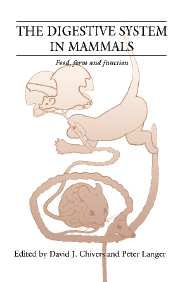Book contents
- Frontmatter
- Contents
- List of contributors
- Preface
- Part I Introduction
- Part II Food
- Part III Form
- Part IV Function
- 18 Foraging and digestion in herbivores
- 19 Gut morphology, body size and digestive performance in rodents
- 20 The integrated processing response in herbivorous small mammals
- 21 Digestive constraints on dietary scope in small and moderately-small mammals: how much do we really understand?
- 22 The effects and costs of allelochemicals for mammalian herbivores: an ecological perspective
- 23 Short-chain fatty acids as a physiological signal from gut microbes
- Part V Synthesis and perspectives
- Index
22 - The effects and costs of allelochemicals for mammalian herbivores: an ecological perspective
Published online by Cambridge University Press: 18 March 2010
- Frontmatter
- Contents
- List of contributors
- Preface
- Part I Introduction
- Part II Food
- Part III Form
- Part IV Function
- 18 Foraging and digestion in herbivores
- 19 Gut morphology, body size and digestive performance in rodents
- 20 The integrated processing response in herbivorous small mammals
- 21 Digestive constraints on dietary scope in small and moderately-small mammals: how much do we really understand?
- 22 The effects and costs of allelochemicals for mammalian herbivores: an ecological perspective
- 23 Short-chain fatty acids as a physiological signal from gut microbes
- Part V Synthesis and perspectives
- Index
Summary
Mammalian herbivores encounter a diverse range of allelochemicals in their diets (Palo and Robbins, 1991). Clearly, theories of foraging behaviour and diet selection must focus on the effects of these substances as well as on nutrients and energy (Belovsky and Schmitz, 1991). This is particularly true for folivores and other browsers, because it is the leaves of trees and woody shrubs that contain the greatest concentration of allelochemicals (Bryant et al, 1991; Cork and Foley, 1991; Meyer and Karasov, 1991).
Several studies have demonstrated that some allelochemicals are strongly deterrent to some herbivores (Clausen etal., 1990, Bryant et ai, 1991, 1992), but many other species ingest significant quantities of, mainly carbon-based, allelochemicals (Cork and Foley, 1991; Meyer and Karasov, 1991; Me Arthur et al., 1991). In most cases, the effect of these allelochemicals on food intake is unknown. This sometimes reflects problems in the analysis of allelochemicals in plants, but also reflects a lack of knowledge of the effects of ingested compounds on animals. Therefore, the occurrence, effects and costs of ingestion of the allelochemicals contained in different plants available to herbivores must form a central part of any theory of mammal-plant interactions.
The effects of allelochemicals on insect herbivores are much more widely documented (e.g. Bernays et al., 1989); small size makes insects amenable to growth studies and the diets of many insects can be manipulated easily. In contrast, vertebrate herbivores are often difficult to maintain for detailed investigation of the effects of different diets on health and metabolism.
- Type
- Chapter
- Information
- The Digestive System in MammalsFood Form and Function, pp. 370 - 391Publisher: Cambridge University PressPrint publication year: 1994
- 38
- Cited by

